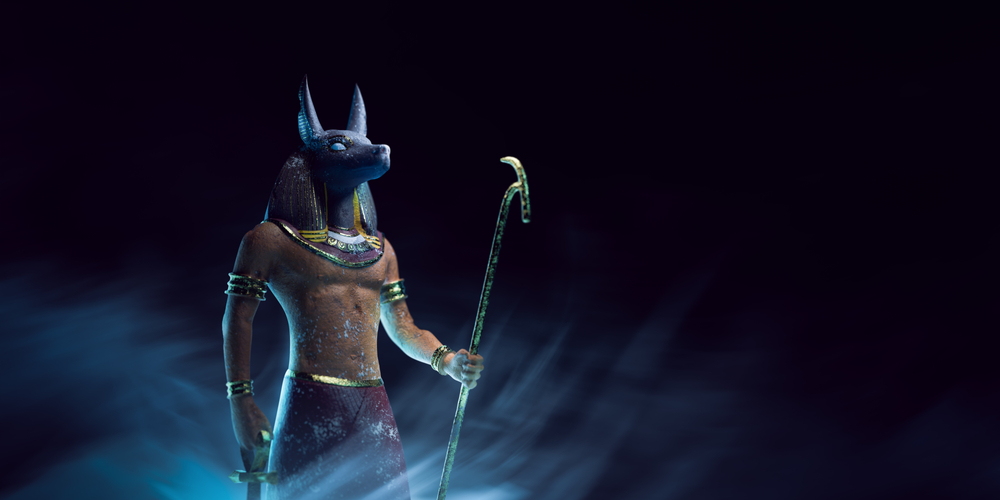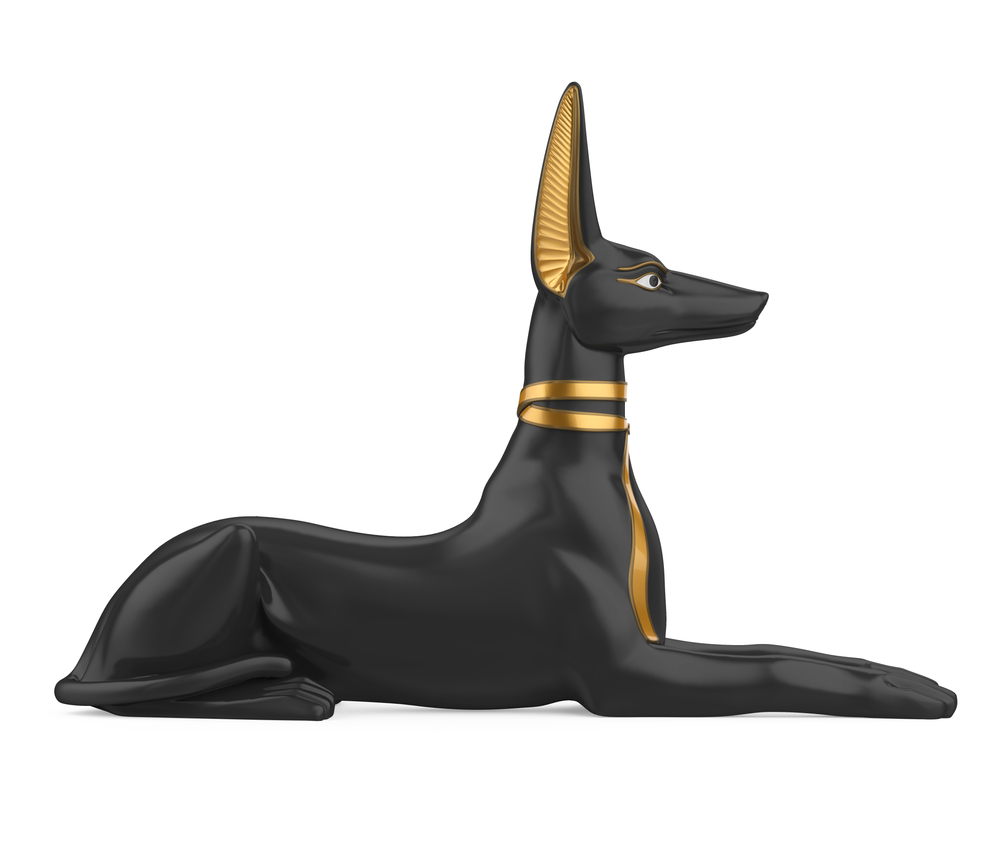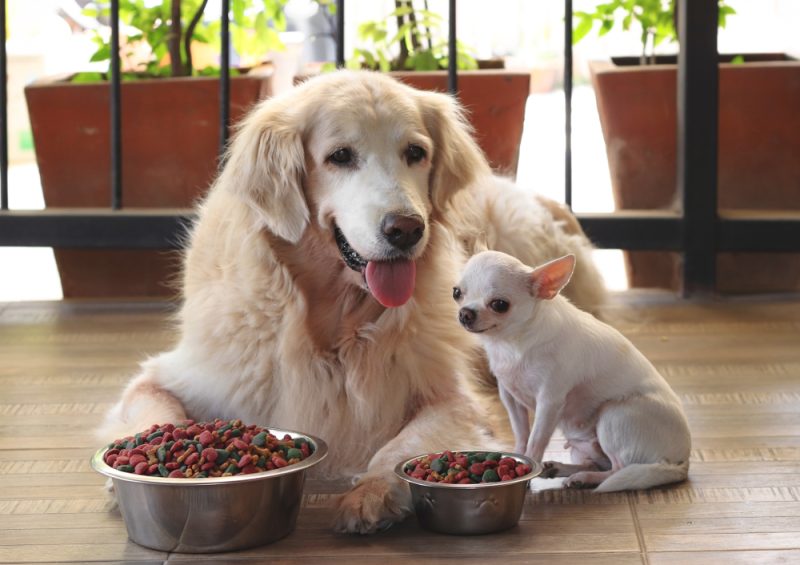Dogs have been a common thread in cultural folklore and mythology since the dawn of civilization. For thousands of years, humans have been praying to or living in mortal fear of our canine counterparts. So, it makes sense that dogs are such an integral part of mythology when you think about how long we’ve been keeping them as pets, protectors, and hunting partners. But if you’re curious as to how other cultures viewed dogs, read on to learn about 16 of the most interesting ancient canine gods, figures, and deities.

How Are Ancient Dog Gods & Deities Classified?
As we alluded to in our introduction, dogs have been part of many cultures’ folklore and mythology. In our list below, you will find dog gods, deities, and figures from the following cultures:
- Ancient Egyptian
- Sumerian and Akkadian
- Aztec
- Greek
- Norse
- Irish
- Celtic
- North American Indigenous
- Philippines
The 16 Ancient Dog Gods and Deities
1. Anubis

- Origin: Ancient Egyptian Mythology
- Role: God of The Underworld
Anubis is the guide to the underworld in ancient Egyptian religions and is typically depicted as a dog or as a man with a dog head. Like many other similar deities, Anubis had different roles depending on the context. He was a protector of graves in the First Dynasty but was also an embalmer and was in charge of weighing the hearts of the deceased to dictate the fate of their souls.
2. Wepwawet
- Origin: Ancient Egyptian Mythology
- Role: Deity of Funerary Rites and War
Wepwawet was an Egyptian god whose role was to help the dead through the dangerous path to the afterlife. He is often paired with Anubis in his protection of the dead, but he has his own independent identity. Wepwawet was depicted as a wolf or jackal or as having a man’s body with the head of a wolf or jackal.
3. Bau
- Origin: Sumerian and Akkadian Mythology
- Role: Goddess of Healing
Bau was a Mesopotamian goddess depicted as a patron deity with a dog head. She’s associated with healing and protection, and the earliest sources represent her as a motherly deity. Bau was associated with other goddesses, like the medicine goddess Ninisina.
4. Ahuizotl
- Origin: Aztec Mythology
- Role: Goddess of Healing
The ahuizotl is a legendary dog-like creature that supposedly lured people to their deaths with a hand situated at the end of its tail. The creature was depicted as an underwater dweller, living near river banks, waiting to drag unwary folks to their watery graves.
5. Xolotl
- Origin: Aztec Mythology
- Role: God of Fire and Lightning
Xolotl is commonly depicted as a dog-headed man, though he sometimes appears as a skeleton or deformed creature. He is also considered the God of Twins, Monsters, and Misfortune. Xolotl is the twin of Quetzalcoatl, the patron god of the Aztec priesthood. The two brothers are said to have descended to Mictlan, the underworld of Aztec mythology. They would travel to Mictlan to gather the bones of the dead to anoint with their blood so they could give birth to the people currently inhabiting the present world.
Fun fact: The Xoloitzcuintli dog breed was named after Xoltol.
6. Cerberus
- Origin: Greek Mythology
- Role: Hound of Hades
While Cerberus wasn’t a god, we still felt he was worthy to be included on this list as he is an important figure in Greek mythology. Cerberus is a multi-headed dog who’s said to guard the gates of the underworld to prevent the dead from escaping and the living from entering. Many gods feared this creature; however, he is perhaps best known for his capture by Heracles.
7. Orthrus
- Origin: Greek Mythology
- Role: Cattle Guardian
Orthrus is a two-headed, serpent-tailed dog whose job was to guard Geryon’s red cattle. He was the brother of Cerberus, and was also killed by Heracles. According to the Ancient Greek poet Hesiod, Orthrus was the father of the Sphinx and the Nemean Lion.
8. Fenrir
- Origin: Norse Mythology
- Role: Child of Loki
Fenrir, sometimes also called Hróðvitnir or Vánagandr, isn’t a dog at all but a monstrous wolf. He’s the son of the demonic god Loki and giantess Angerboda. He is known for his super strength and the role he plays as a powerful nemesis to the gods.
9. The Morrigan
- Origin: Irish Mythology
- Role: Goddess of War
The Morrigan is one of the best-known mythical characters in Irish folklore. She is a gifted shapeshifter, often taking the shape of a wolf. She’s mostly associated with war and fate, especially in the foretelling of doom and death, though she’s also sometimes associated with land and animals.
10. Kimat
- Origin: Philippine Mythology
- Role: Dog of Kadlagan
Kadlagan is the god of thunder, who lives with his dog Kimat. Kimat is a lightning spirit depicted as a large white dog who will do whatever his master asks him to.
11. Coyote

- Origin: North American Indigenous Tribes
- Role: Mythological character
The coyote is a mythological creature common to countless cultures of North American Indigenous peoples. The myths surrounding the character vary greatly from culture to culture. However, he is typically viewed as an anthropomorphic trickster god with traits similar to the animal he shares a name with.
12. Duamutef
- Origin: Ancient Egyptian Mythology
- Role: Protection God of the Canopic Jars
Duamutef was one of the Four Sons of Horus, a group of four Egyptian gods who protect the dead souls. Each of the four gods appears as canopic jars. Canopic jars were used during the mummification process to store and preserve the viscera of the owner for the afterlife.
13. Sarama
- Origin: Hindu Mythology
- Role: Female Dog of the Gods
Sarama’s first appearance was in the Rig Veda, a collection of Vedic Sanskrit hymns. In the Rig Veda, Sarama assists the king of the gods in recovering cows that were stolen. In the Puranas, the vast genre of Hindu literature known for the layers of symbolism depicted within each story, Sarama is considered to be not just the mother of dogs but mother to all creatures.
14. Cernunnos
- Origin: Celtic Mythology
- Role: Lord of Wild Things
Cernunnos is a god often depicted with antlers and associated with dogs and stags. He is a mysterious deity, as his original mythos has been lost through time, though it is generally believed that he was a mediator of man and nature.
15. Garm
- Origin: Norse Mythology
- Role: Guardian of the gates to the afterlife
Garm, or Garmr, had a very similar job to Cerberus as he acted as guardian for the gates to the afterlife. He was depicted as a wolf or dog, though that’s about all the information available for him as all other references are extremely vague. In one of the poems in a collection of Old Norse poetry, Garmr is said to be to dogs what Odin is to gods.
16. Set
- Origin: Ancient Egyptian Mythology
- Role: God of Deserts and Storms
Set was a storm god in Egyptian mythology. He was responsible for eclipses, thunderstorms, and other weather and geological disturbances that were unpredictable and terrifying at the time. He is often depicted as an enigmatic creature not identifiable as any known animal, though he does resemble an African wild dog with his slender canine body.
See Also:
- What Dog Breed Is Anubis? Interesting Facts & History
- Cerberus Dog: The Hellhound of Greek Mythology
Featured Image Credit: Nerthuz, Shutterstock


















